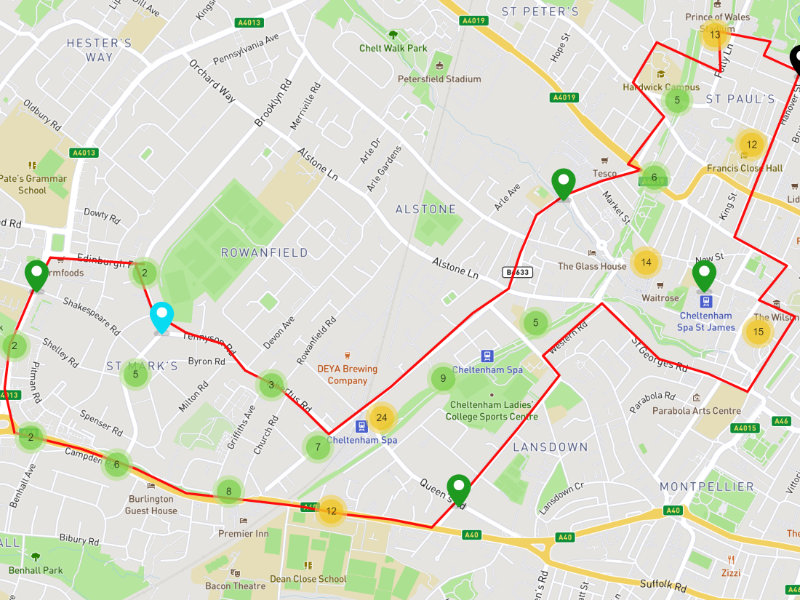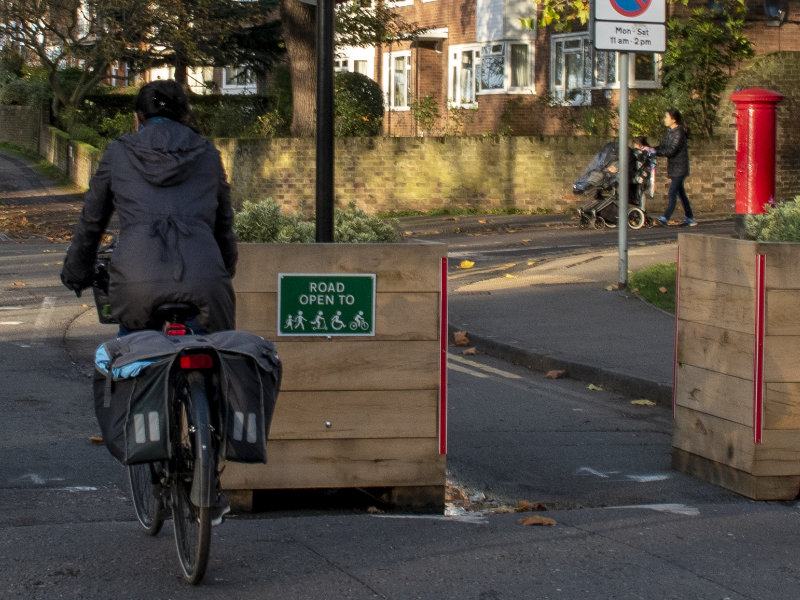Gloucestershire County Council recently consulted on proposals to introduce the first modern ‘mini-Holland’ scheme in Gloucestershire.

As we highlighted to members and followers during the consultation period, the mini-Holland guidance sets a high standard for councils, expecting significant decreases in motor vehicle traffic and improvements in cycle and walking connectivity. The future bid will be assessed with multiple tools, testing;
- Quality of the network developed
- Porosity (how easy to get around)
- Mesh density (number of routes available)
- Permeability (how motor traffic can get in/out)
- Rat running resolution
- Perimeter treatment design (eg crossings of sidearms of strategic roads)
- Internal treatment design (how traffic is calmed within the area)
- Placemaking
- Engagement practice
This is the first major scheme we have seen that doesn’t focus on a single long distance route, the perils of which we have previously highlighted.
As such, we are watching with interest and hope to contribute in due course as plans develop.

We submitted the following comments to the consultation, raising specific issues around cycle connectivity, highlighting strategic interfaces with the mini-Holland area, and encouraging the council to lead on the need for reducing motor vehicle traffic and promoting conditions for walking and cycling.
Our response to the Cheltenham Mini-Holland
We welcome that the county council have started this process to secure funding to help increase walking and cycling in this area of Cheltenham and we are keen to support the process.
We have been active in this field of work both locally and nationally for some time and so have skills to offer in drawing together ideas and formulating bids. The guidance from the DfT asks that the local authority needs to work closely with communities and have good stakeholder engagements.
To this end we would welcome early engagement with the Cheltenham & Tewkesbury Cycling Campaign as you now proceed, to assist you in meeting the high standards set for these schemes.
General Comments
The county highways have focused very much on increasing road capacity and has to date been resistant to general speed reduction in urban areas. We believe any significant increase in walking and cycling will only come about if there is a change in culture in relation to driving, with lower traffic volumes and lower speeds, and a recognition that the needs of pedestrians and cycle users are different.
This project is a big opportunity for the county to demonstrate it is committed to tackling issues at local street level, and decreasing motor vehicle desirability in favour of active travel.
A small mini-Holland would be helpful within the locality proposed, but its impact would be limited by the constraints in the town as a whole. A wider strategy is needed if it is to really achieve its objectives, and this small scheme must rapidly be followed by a whole town approach.
It is also worth bearing in mind that the guidance given in relation to the funding offered requires an exceptional level of design, which will require close collaboration.
As a committee, along with our members, we have added a number of challenges to the consultation map, including those featured on our existing Cheltenham ‘wish list ’.
Along with these point issues, the local scheme reveals a number of strategic challenges that will need to be considered;
Strategic challenges for the mini-Holland scheme
Honeybourne Line
As part of this project, it is important to consider wider missing strategic links. Upgrading the Honeybourne line is key to filling the missing links, but must be treated as a separate issue to how we can make the surrounding streets more conducive to cycling and walking.
On the plan issued as part of the consultation the route is shown as continuing to Shelbourne Road. This extension seems to have stalled, with no evidenced progress by GWR or Network Rail. We are unsure what the issue is, as after the feasibility study some 40 years ago, the works contract has still not been let.
The Honeybourne line continues to be poorly maintained. We are also concerned that there are real capacity constraints particularly on the section between St Georges Road and Bayshill/ Chapel Lane, and the expectation that a shared space can deliver high volume strategic capacity is unrealistic. If the line is to be the spine of the mini-Holland, it is perhaps time for it to be adopted by GCC to ensure it receives the parity it requires.
We also note that on the consultation area sketch plan, Millbrook Street and New Street is shown as a continuous route. This was severed some years ago with the building of Waitrose and has been a key barrier for walking and cycling as identified by us from the date of its severance.
At the northern end of the route we have promoted the idea of a link across the Honeybourne Line from Wymans Brook to Albemarle Gate. At present this is a muddy informal track, important particularly for school children. The way the map is drawn it is just outside the area of the proposed scheme, and we are disappointed that the initial aspiration that this would be a north Cheltenham focussed scheme mean it will be missed.
Before the development of Waitrose the Borough had identified a western route linked to the Honeybourne line and town centre through open space and across Gloucester Road. We have as a campaign returned to look again at this idea, which could offer another significant strategic route in support of the scheme.
Queens Road and Cheltenham Spa Station
The area around the station entrance on Queens Road is particularly challenging for pedestrians. Matters have not been helped with the new layout at the station which has made access for bus users, pedestrians and cyclists worse, whilst maximising car parking spaces. We are already communicating with GWR and Network Rail on this, but would welcome your engagement and support on these issues.
The mini-Holland consultation process to date
Mini-holland schemes have sometimes been controversial in other areas. We would hope that the county council would act as champion for the mini-Holland project, engaging more widely with local businesses, community groups and residents, with face-to-face meetings indoors in suitable venues, wholesale leafleting, as well use of social media.
The consultation, to date, has not begun building this momentum, and we suspect it has had very limited reach.
It will need visible and proactive leadership within the council to hold an evidence-based, strategic course until benefits are realised.
It will not be successfully delivered from a position of ambivalence or maintenance of the status quo.
We would also urge the council to use positive images that are relevant to the target audience. The image on the initial leaflet showed a sports cyclist rather than an everyday cyclist. Positive images showing what a mini Holland would mean in practice such as a pedestrian in a pleasant street scene would be helpful, and we are happy to help you identify schemes elsewhere that might provide this.
We welcome this positive opportunity to create accessible and enjoyable local streets for walking and cycling, and hope that there will be opportunities to collaborate as the proposals are now developed.
